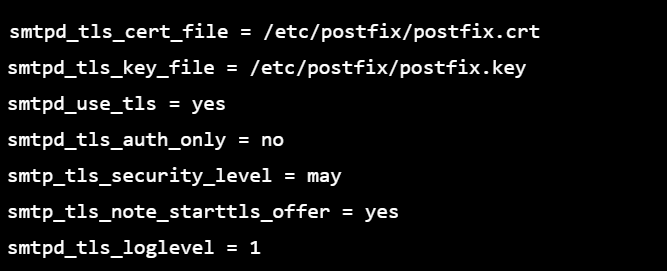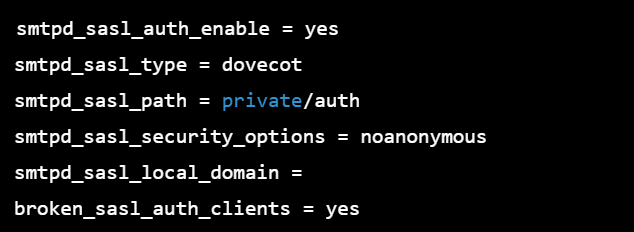Best practices for securing your SMTP server
How to monitor the logs of your SMTP server to detect any suspicious activity with example
Disable Unnecessary Services to protect smtp server with example
how to Update Software Regularly to secure smtp server with example
how to use SSL/TLS encryption for incoming and outgoing email with example
how to Implement SMTP-AUTH through the SMTP server
Here are some best practices for securing your SMTP server:
Use Strong Passwords: Use complex passwords that are difficult to guess or crack, and change them regularly.
Update Software Regularly: Regularly update the software and operating system running on your SMTP server to ensure that it has the latest security patches.
Disable Unnecessary Services: Disable any services that are not needed on the SMTP server to reduce the attack surface.
Use Encryption: Use encryption for email communication to protect sensitive information in transit. For example, use SSL/TLS encryption for incoming and outgoing email.
Implement Firewall Rules: Implement firewall rules to restrict access to the SMTP server to only authorized IP addresses.
Monitor Logs: Regularly monitor the logs of your SMTP server to detect any suspicious activity.
Implement Authentication: Implement authentication mechanisms, such as SMTP-AUTH, to ensure that only authorized users can send email through the SMTP server.
Use Antivirus Software: Install and regularly update antivirus software to detect and prevent malware infections.
Here is an example of how to secure an SMTP server running on Ubuntu Linux:
1.install and configure a firewall, such as "ufw", to restrict access to the SMTP server:
sudo apt-get install ufw
sudo ufw allow 25/tcp
sudo ufw enable
2.Install and configure SSL/TLS encryption for incoming and outgoing email using "Postfix" and "Certbot":
sudo apt-get install postfix
sudo apt-get install certbot
sudo certbot --nginx
sudo nano /etc/postfix/main.cf
In the main.cf file, set the following parameters:
smtpd_tls_cert_file = /etc/letsencrypt/live/[domain name]/fullchain.pem
smtpd_tls_key_file = /etc/letsencrypt/live/[domain name]/privkey.pem
smtpd_use_tls=yes
smtpd_tls_auth_only = yes
3.Implement SMTP-AUTH using "Postfix":
sudo nano /etc/postfix/main.cf
In the main.cf file, set the following parameters:
smtpd_sasl_auth_enable = yes
smtpd_sasl_security_options = noanonymous
smtpd_sasl_type = dovecot
smtpd_sasl_path = private/auth
These are just a few examples of best practices for securing your SMTP server. It is recommended to consult with a security expert for a comprehensive security plan for your SMTP server.
How to monitor the logs of your SMTP server to detect any suspicious activity with example
To monitor the logs of your SMTP server to detect any suspicious activity, you can use various log analysis tools and techniques. Here is an example using "rsyslog" in Ubuntu Linux:
1.Install "rsyslog":
sudo apt-get install rsyslog
2.Configure "rsyslog" to log messages from the SMTP server:
sudo nano /etc/rsyslog.conf
In the rsyslog.conf file, add the following line:
mail.* /var/log/mail.log
3.Restart "rsyslog" to apply the changes:
sudo service rsyslog restart
4.View the logs:
sudo tail -f /var/log/mail.log
This will display the logs generated by the SMTP server in real-time. You can also use tools such as "grep" to search for specific patterns in the logs. For example, you can search for the number of emails sent by a particular user:
sudo grep 'from=<user@example.com>' /var/log/mail.log | wc -l
These are just a few examples of how to monitor the logs of your SMTP server to detect any suspicious activity. It is important to regularly review the logs and implement automated tools and techniques to detect any unusual activity. Additionally, it is recommended to consult with a security expert for a comprehensive security plan for your SMTP server.
Disable Unnecessary Services to protect smtp server with example
Disabling unnecessary services on your SMTP server can reduce the attack surface and increase security. Here is an example using "Postfix" on Ubuntu Linux:
1.Identify the services running on the SMTP server:
sudo netstat -tulpn
This will display a list of all the services running on the system and the ports they are listening on.
2.Disable services that are not needed:
For example, to disable the "IMAP" service, edit the Postfix configuration file:
sudo nano /etc/postfix/main.cf
In the main.cf file, comment out the line that starts with "inet_interfaces =" to disable the service:
inet_interfaces = all
3.Restart the SMTP server to apply the changes:
sudo service postfix restart
It is important to only disable services that are not needed for your specific use case, as disabling the wrong services could impact the functionality of the SMTP server. It is also recommended to consult with a system administrator or security expert to ensure that the changes do not impact the functionality or security of the SMTP server.
how to Update Software Regularly to secure smtp server with example
Updating software regularly is an important step in securing your SMTP server. Updating software ensures that any security vulnerabilities or bugs are fixed, and new features and improvements are added. Here is an example using "Postfix" on Ubuntu Linux:
1.Check the current version of Postfix installed:
postconf -d | grep mail_version
2.Update the package list:
sudo apt-get update
3.Upgrade the installed packages:
sudo apt-get upgrade
4.Restart the SMTP server:
sudo service postfix restart
This is just an example of how to update software on an SMTP server running Ubuntu Linux and Postfix. The exact steps may vary depending on your operating system and SMTP server software. It is important to update software regularly to ensure that your SMTP server is secure and functioning optimally. It is also recommended to set up automatic updates to ensure that your SMTP server is always up-to-date.
how to use SSL/TLS encryption for incoming and outgoing email with example
Using SSL/TLS encryption for incoming and outgoing email helps to secure the communication between your SMTP server and the email clients. Here is an example using "Postfix" on Ubuntu Linux:
1.Install the "openssl" package:
sudo apt-get install openssl
2.Generate a self-signed SSL certificate:
sudo openssl req -new -newkey rsa:2048 -nodes -keyout /etc/postfix/postfix.key -out /etc/postfix/postfix.csr
sudo openssl x509 -req -days 3650 -in /etc/postfix/postfix.csr -signkey /etc/postfix/postfix.key -out /etc/postfix/postfix.crt
3.Configure Postfix to use the SSL certificate:
Edit the main configuration file for Postfix:
sudo nano /etc/postfix/main.cf
Add the following lines to the file:
smtpd_tls_cert_file = /etc/postfix/postfix.crt
smtpd_tls_key_file = /etc/postfix/postfix.key
smtpd_use_tls = yes
smtpd_tls_auth_only = no
smtp_tls_security_level = may
smtp_tls_note_starttls_offer = yes
smtpd_tls_loglevel = 1
4.Restart Postfix:
sudo service postfix restart
This is just an example of how to configure SSL/TLS encryption for incoming and outgoing email using Postfix on Ubuntu Linux. The exact steps may vary depending on your operating system and SMTP server software. It is important to use SSL/TLS encryption to secure the communication between your SMTP server and the email clients, and to use a trusted SSL certificate from a reputable certificate authority for best security.
how to Implement SMTP-AUTH through the SMTP server
SMTP-AUTH (SMTP Authentication) is a mechanism for allowing clients to authenticate themselves to an SMTP server before sending email. Implementing SMTP-AUTH through your SMTP server helps to prevent unauthorized use of the server and enhances security. Here is an example using "Postfix" on Ubuntu Linux:
1.Install the "sasl2-bin" package:
sudo apt-get install sasl2-bin
2.Edit the main Postfix configuration file:
sudo nano /etc/postfix/main.cf
3.Add the following lines to the file:
smtpd_sasl_auth_enable = yes
smtpd_sasl_type = dovecot
smtpd_sasl_path = private/auth
smtpd_sasl_security_options = noanonymous
smtpd_sasl_local_domain =
broken_sasl_auth_clients = yes
Restart Postfix:
sudo service postfix restart
This is just an example of how to implement SMTP-AUTH through the SMTP server using Postfix on Ubuntu Linux. The exact steps may vary depending on your operating system and SMTP server software. It is important to configure SMTP-AUTH properly to prevent unauthorized use of the SMTP server and to ensure the security of your email communications.



























Top comments (0)